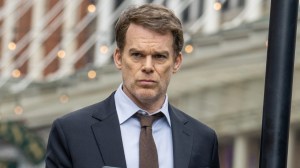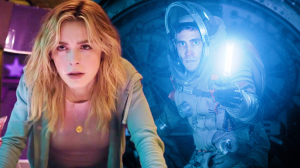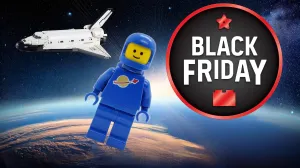This summer, Toy Story fans get to see Buzz in a brand new light. Pixar’s Lightyear gives the beloved action figure an origin, being presented as the movie that the Buzz Lightyear toy was based on in the first place. Instead of a delusional toy, this version of Buzz is a stoic hero, one that inspired so many kids around the world that his action figure became the most popular toy on the planet. So, not only is the tone of Lightyear different from that of the Toy Story films, but the very fabric of Buzz as a character has been altered.
Videos by ComicBook.com
The version of Buzz featured in the upcoming Lightyear had to be a heroic action figure, but he also had to resemble the version of Buzz that fans know and love. This challenge was one of the most important facing the creative team behind Lightyear. At an early press day for the new Pixar film, ComicBook.com spoke with some of the filmmakers about transforming the Toy Story icon.
“Because he’s a side character in Toy Story, we were going to try to figure out how to pour it into a main character, but we needed to keep a certain aesthetic, a certain sensibility to his lantern jawed squareness, but do it in a way that felt like it was motivated by something,” director Angus MacLane explained. “That we spent maybe more time on trying to cause otherwise. We found pretty quickly if you watch Toy Story again, you imagine a whole movie [with that Buzz], which is the guy going, ‘Well, I’m going over here. Look, I’m going over there. Oh no, look, monsters!’ You get tired of that pretty quickly. And so the idea, some of the revelations of how we were able to thread that needle and making it more well rounded character were essential to maintaining a feature.”
“But we knew that he needed to have a big chin, and he needed to have a chin dimple, and he was going to wear that purple snood,” added producer Galyn Susman. “And there were elements that visually we knew people were expecting the suit, that space suit that you didn’t want to disappoint. But again, it’s also about how do you bring that into that next level of design where it feels like… A human. Not a live action human, but a human human.”
The writing of Lightyear and casting of Chris Evans are obvious examples of ways the team altered their approach to the classic character, but there was also a lot of heavy lifting done by the animation itself. We spoke to Lightyear‘s tailoring and simulation supervisor, Fran Kalal, about how the actual design of Buzz and his suit affects the way we look at him.
“When you think about the toy, and that’s our earliest touch base, you think about the silhouette, iconic parts of this toy,” Kalal explained. “And when you close your eyes and open them real quick what do you think of when you think about Buzz Lightyear the toy? You think about the helmet. You think about the ball joint shoulders. You think about the pointy elbows and the knees. These are some of the things that come into your mind. And so when we’re thinking about the hero Buzz Lightyear, that inspired the toy, what we do is we build the human. We actually build the Buzz human and then we start bringing over the rough shapes are one of the things that remind you of that costume.”
“So those shoulders and that helmet and the knees and the elbows. We start bringing those over and sort of roughly sizing them to a Buzz of human proportions,” Kalal continued. “And it’s super, super interactive. In these interactive sessions the art directors and the director, Angus, and our modeling team and our animation team all together in a live session resizing these pieces. Then our modeling team goes in and puts all of the cool panel details in it that tell you, just by looking at it, that humans made it for someone at human scale.”
Kalal went on to explain how each little detail found on Buzz’s suit in Lightyear points toward him being an actual human, rather than a manufactured toy, helping to set him apart from the previous version.
“So on a toy there’s manufacturing scenes, intentionally, right? This is the plastic molding, here’s the little screw sockets where this went in,” she said. “So you’ve got all those cues that it’s made by humans at toy scale. But the suit that you see on the hero Buzz Lightyear has all these manufacturing details that show you that it was made by humans for humans scale. Which is really, really cool it’s a new level of hard surface modeling. And on top of that, you put the shading on and the shading is done to show human scale wear. Like where two pieces slide together you might see some paint rubbing off a little bit like in a scale that makes sense for humans.”
Buzz is hitting the big screen on June 17th when Lightyear is released in theaters around the country, and fans should expect to see a very different space ranger than they’re used to.








